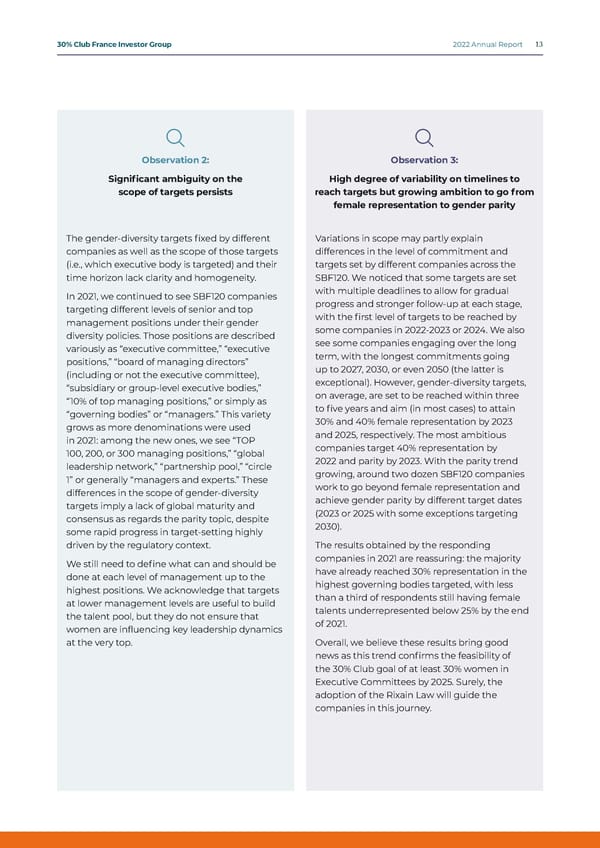2022 Annual Report 13 30% Club France Investor Group Observation 2: Significant ambiguity on the scope of targets persists The gender-diversity targets fixed by different companies as well as the scope of those targets (i.e., which executive body is targeted) and their time horizon lack clarity and homogeneity. In 2021, we continued to see SBF120 companies targeting different levels of senior and top management positions under their gender diversity policies. Those positions are described variously as “executive committee,” “executive positions,” “board of managing directors” (including or not the executive committee), “subsidiary or group-level executive bodies,” “10% of top managing positions,” or simply as “governing bodies” or “managers.” This variety grows as more denominations were used in 2021: among the new ones, we see “TOP 100, 200, or 300 managing positions,” “global leadership network,” “partnership pool,” “circle 1” or generally “managers and experts.” These differences in the scope of gender-diversity targets imply a lack of global maturity and consensus as regards the parity topic, despite some rapid progress in target-setting highly driven by the regulatory context. We still need to define what can and should be done at each level of management up to the highest positions. We acknowledge that targets at lower management levels are useful to build the talent pool, but they do not ensure that women are influencing key leadership dynamics at the very top. Observation 3: High degree of variability on timelines to reach targets but growing ambition to go from female representation to gender parity Variations in scope may partly explain differences in the level of commitment and targets set by different companies across the SBF120. We noticed that some targets are set with multiple deadlines to allow for gradual progress and stronger follow-up at each stage, with the first level of targets to be reached by some companies in 2022-2023 or 2024. We also see some companies engaging over the long term, with the longest commitments going up to 2027, 2030, or even 2050 (the latter is exceptional). However, gender-diversity targets, on average, are set to be reached within three to five years and aim (in most cases) to attain 30% and 40% female representation by 2023 and 2025, respectively. The most ambitious companies target 40% representation by 2022 and parity by 2023. With the parity trend growing, around two dozen SBF120 companies work to go beyond female representation and achieve gender parity by different target dates (2023 or 2025 with some exceptions targeting 2030). The results obtained by the responding companies in 2021 are reassuring: the majority have already reached 30% representation in the highest governing bodies targeted, with less than a third of respondents still having female talents underrepresented below 25% by the end of 2021. Overall, we believe these results bring good news as this trend confirms the feasibility of the 30% Club goal of at least 30% women in Executive Committees by 2025. Surely, the adoption of the Rixain Law will guide the companies in this journey.
 2022 Annual Report Page 12 Page 14
2022 Annual Report Page 12 Page 14